Blue Spring State Park
- January 8, 2024
- 0 comment
Located along the scenic St. Johns River in Orange City, Florida, Blue Spring State Park stands as a captivating testament to the state’s natural splendor. This enchanting destination, encompassing lush landscapes and a vibrant aquatic ecosystem, beckons visitors year-round with its diverse array of outdoor activities. The park’s main attraction is the Volusia Blue Spring, a mesmerizing natural spring with consistently refreshing 72-degree waters that play host to a remarkable winter gathering of Florida manatees.

Beyond the allure of these gentle giants, the park boasts extensive trails for hiking enthusiasts, waterways for canoeing and kayaking adventures, and serene spots for picnics amidst the picturesque surroundings. With its rich history dating back to the 18th century, Blue Spring State Park seamlessly blends conservation efforts, recreational pursuits, and the preservation of pristine natural habitat, making it a must-visit haven for nature lovers and those seeking a tranquil escape in the heart of Florida.
Characterizing Features of the Blue Spring State Park
- Volusia Blue Spring: Blue Spring State Park is distinguished by the captivating Volusia Blue Spring, the largest spring on the St. Johns River. With a consistent temperature of 72°F (23°C), the spring serves as a haven for Florida manatees seeking warmth during the winter months. The crystal-clear waters provide an ideal setting for snorkeling, diving, and observing the gentle giants in their natural habitat.
- Historical Significance: Boasting a rich history, Blue Spring has been a point of interest since botanist John Bartram’s visit in 1766. The park’s past includes the Weismore family’s acquisition of the land in the mid-19th century, with a plantation-style home built on a shell mound. The Thursbys, who later owned the property, transitioned from citrus cultivation to promoting tourism, taking advantage of the spring’s beauty and the abundant fishing and hunting opportunities along the St. Johns River.
- Conservation Success: A testament to effective conservation measures, the park has seen a remarkable increase in manatee numbers over the years. In 1970, researchers tracked 14 manatees in the spring run, a figure that soared to a record 729 by 2023. The Florida Department of Environmental Protection acquired the park in 1972, kick-starting a manatee protection program that has contributed significantly to this success story.
- Wildlife Diversity: Blue Spring State Park is a haven for wildlife enthusiasts, offering sightings of various species beyond manatees. The spring run and surrounding areas attract wading birds, ospreys, eagles, kingfishers, alligators, bears, raccoons, and numerous bird species. The park’s commitment to preserving diverse ecosystems ensures a flourishing habitat for an array of flora and fauna.
- Recreational Opportunities: With 51 campsites and six cabins, Blue Spring State Park invites visitors to extend their stay and immerse themselves in its natural wonders. The park offers a range of recreational activities, including canoeing, kayaking, fishing, hiking, and wildlife watching. During manatee season (mid-November to March), some water-related activities are restricted to protect the migrating manatees.
- Environmental Challenges: Despite its natural beauty, the park faces environmental challenges. The increasing number of visitors, coupled with the manatees’ presence, has led to heightened environmental stress. Both human and manatee activities contribute to water pollution, resulting in the growth of filamentous algae in the spring area. Additionally, groundwater pumping in nearby cities has led to a decrease in the natural water supply to the spring, impacting its overall output.
- Educational and Research Initiatives: Blue Spring State Park actively contributes to manatee research, with records dating back to 1978. Researchers document the life history of individual manatees, including births, deaths, and relationships, creating one of the world’s longest-running and comprehensive manatee databases. Live video streaming during manatee season allows the public to witness and learn about these gentle giants, fostering awareness and understanding of their behavior and habitat.
- Picturesque Setting and Amenities: The park’s aesthetics are further enhanced by the scenic spring run, a few miles long, and a 1/3-mile boardwalk stretching from the St. Johns River to the headspring. Pavilions, picnic tables, volleyball courts, and a playground provide ample recreational spots for families and groups. The historic Thursby plantation house, maintained within the park, offers historical displays for those interested in the region’s past.
Blue Spring State Park, with its amalgamation of natural beauty, historical significance, and conservation efforts, stands as a multifaceted destination that caters to the interests of both outdoor enthusiasts and those seeking an educational and serene escape in Florida’s enchanting landscapes.
History
Blue Spring State Park, located in Orange City, Florida, boasts a rich and diverse history that spans centuries. The area gained botanical significance when renowned botanist John Bartram explored its natural wonders in 1766. In the mid-19th century, the Weismore family acquired the land, constructing a grand plantation-style home atop a shell mound, envisioning it as an ideal site for cultivating citrus fruit. However, the freeze of the 1890s devastated the citrus groves, prompting the Thursby family, who later owned the property, to shift their focus to tourism.
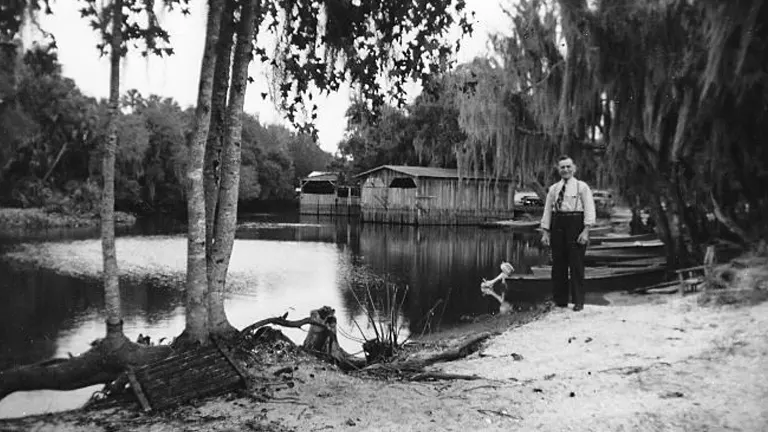
The park’s allure expanded to include the beautiful spring and the excellent fishing and hunting opportunities along the St. Johns River. In 1972, recognizing the need for conservation and manatee protection, the Florida Department of Environmental Protection acquired the park. Since then, it has played a crucial role in the preservation of the environment and the facilitation of extensive research on the manatee population. Today, Blue Spring State Park stands not only as a testament to the region’s natural beauty but also as a beacon of successful conservation efforts and a place where visitors can connect with Florida’s ecological and historical heritage.
Importance in Conservation and Recreation of Blue Spring State Park
Blue Spring State Park stands as a pivotal hub for both conservation and recreation, showcasing a harmonious blend of natural preservation and outdoor enjoyment. Renowned for its role in manatee protection, the park has been instrumental in the success of Florida’s conservation initiatives. Since its acquisition by the Florida Department of Environmental Protection in 1972, Blue Spring State Park has served as a key player in the safeguarding of the endangered manatee population. Researchers have meticulously recorded the life history of individual manatees, contributing invaluable data to one of the world’s longest-running manatee databases.
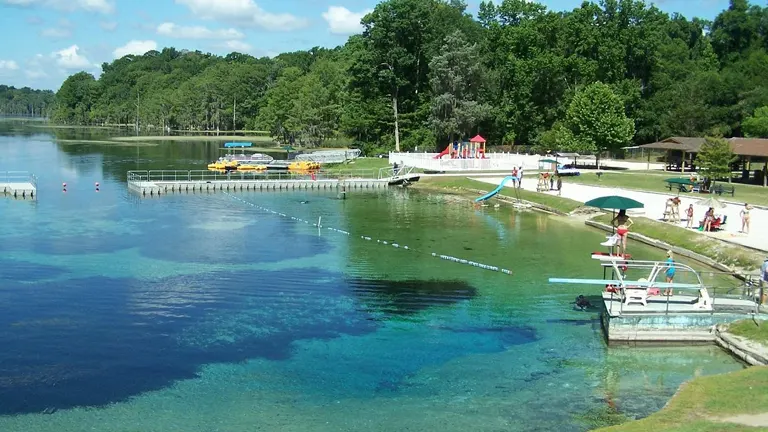
The park’s efforts have yielded remarkable results, with manatee numbers surging from 14 in 1970 to a record-breaking 729 by 2023. Beyond its conservation significance, Blue Spring State Park offers a plethora of recreational opportunities, from hiking trails and water activities like canoeing and kayaking to camping amidst its scenic landscapes. Visitors can immerse themselves in the pristine surroundings, gaining an appreciation for the diverse ecosystems that thrive within the park. As a haven for wildlife enthusiasts and nature lovers, Blue Spring State Park not only safeguards the delicate balance of its natural environment but also provides a sanctuary for outdoor enthusiasts to connect with Florida’s ecological wonders.
Unique Location of Blue Spring State Park
Located along the serene banks of the St. Johns River in Orange City, Florida, Blue Spring State Park boasts a location that sets it apart as a true gem within the state’s natural landscape. Positioned on the west side of Orange City, the park offers a tranquil retreat just a short drive from the bustling urban areas, making it a convenient yet remarkably serene escape. What makes its location particularly unique is the convergence of aquatic wonders – the park’s centerpiece, the Volusia Blue Spring, is the largest spring on the St. Johns River, attracting not only human admirers but also serving as a vital winter refuge for Florida manatees seeking the constant 72-degree Fahrenheit warmth.
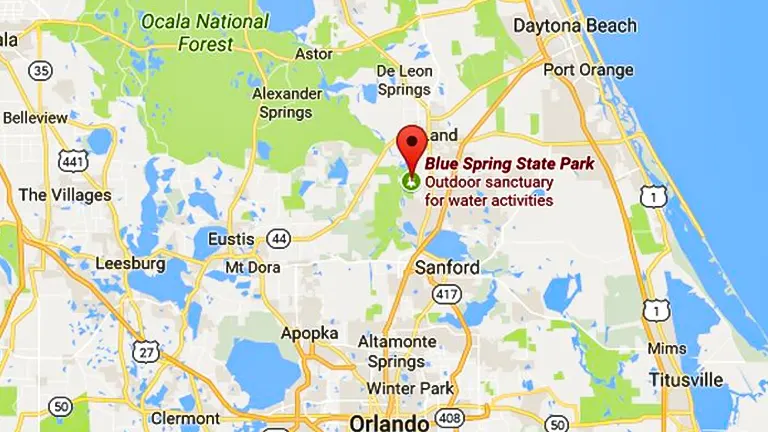
The park’s setting within the larger St. Johns River system adds to its ecological significance, creating a haven for diverse wildlife and offering visitors an immersive experience where the natural beauty of Florida unfolds against the backdrop of a gently flowing river. This distinctive location positions Blue Spring State Park as a haven for both urban dwellers seeking a peaceful retreat and nature enthusiasts eager to explore the dynamic ecosystems that thrive along the St. Johns River.
Diverse Vegetation and Plant Species in Blue Spring State Park
- Bald Cypress Trees (Taxodium distichum): Towering along the spring run and St. Johns River, the bald cypress trees at Blue Spring State Park provide not only stunning visuals but also create important shaded habitats for various aquatic species. Their distinctive “knees” emerge from the water, contributing to the unique ecology of the park.
- Live Oaks (Quercus virginiana): Blue Spring is adorned with sprawling live oak trees, forming part of the hardwood hammocks. These evergreen oaks offer year-round shade and are vital for supporting a myriad of bird species. Spanish moss often drapes from their branches, enhancing the park’s enchanting ambiance.
- Longleaf Pine (Pinus palustris) Forests: Contributing to the diverse vegetation, Blue Spring State Park houses longleaf pine forests. These ecosystems play a crucial role in maintaining soil stability and offer habitat for various wildlife species, showcasing the park’s commitment to preserving Florida’s native plant communities.
- Slash Pine (Pinus elliottii): Alongside longleaf pines, slash pines are prevalent in certain areas of the park. The mix of pine species adds to the overall biodiversity, creating a mosaic of habitats that supports a wide range of flora and fauna.
- Eelgrass (Vallisneria americana): Beneath the clear waters of Volusia Blue Spring, eelgrass forms dense underwater meadows. This aquatic plant not only contributes to the spring’s aesthetic appeal but also provides essential habitat and food for fish and invertebrates, sustaining the park’s intricate aquatic ecosystem.
- Saw Palmetto (Serenoa repens) Scrub: The park features areas dominated by saw palmettos, creating palmetto scrub habitats. These low-growing palms offer cover for small wildlife and contribute to the park’s mosaic of vegetation types, showcasing the diversity of Florida’s plant life.
- Florida Wildflowers: Throughout the park, native wildflowers, including Coreopsis and Tickseed Sunflower, paint the landscape with vibrant colors, particularly during the spring season. These wildflowers support pollinators and add to the overall biodiversity of the park.
- Spanish Moss (Tillandsia usneoides): Draping gracefully from tree branches, Spanish moss lends an ethereal quality to the park’s scenery. This epiphytic bromeliad not only adds to the park’s visual charm but also serves as nesting material for birds and provides a habitat for insects.
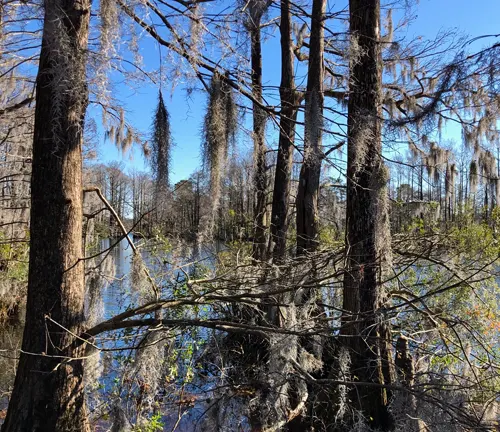
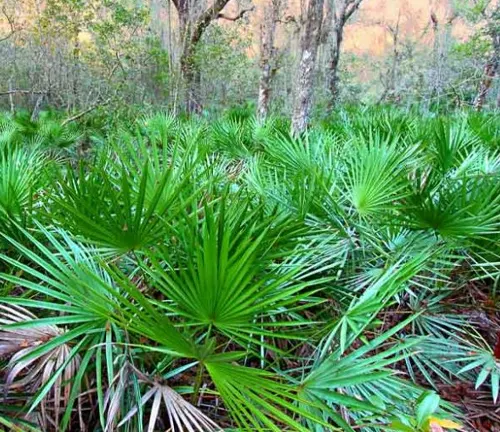
The intricate tapestry of plant species at Blue Spring State Park showcases the region’s ecological richness, offering visitors a detailed glimpse into the diverse flora that sustains the park’s vibrant ecosystems.
Fauna
- Florida Manatees (Trichechus manatus latirostris): Blue Spring State Park is renowned for being a critical winter refuge for the endangered Florida manatee. During the colder months, these gentle giants seek the constant 72-degree Fahrenheit waters of Volusia Blue Spring, offering visitors a unique opportunity to witness their graceful movements.
- Alligators (Alligator mississippiensis): The park is home to a population of American alligators, adding to the diversity of its wildlife. Visitors may spot these reptiles basking in the sun along the banks of the St. Johns River or the spring run.
- Barred Owls (Strix varia): The lush hardwood hammocks and pine forests provide an ideal habitat for barred owls. Known for their distinctive calls, these nocturnal birds of prey are often spotted in the park, especially during the quieter hours of dawn and dusk.
- River Otters (Lontra canadensis): Blue Spring State Park is inhabited by playful river otters, which can be observed swimming and foraging along the waterways. These semi-aquatic mammals add to the park’s charismatic wildlife and are a delight for wildlife enthusiasts.
- White-Tailed Deer (Odocoileus virginianus): The park’s diverse vegetation and habitats support a population of white-tailed deer. These graceful mammals can be encountered in wooded areas, showcasing the park’s role in providing a haven for native terrestrial wildlife.
- Bald Eagles (Haliaeetus leucocephalus): Blue Spring State Park is frequented by bald eagles, symbolizing the success of conservation efforts in the region. Visitors may witness these majestic birds soaring above the treetops, reflecting the park’s significance in supporting avian biodiversity.
- Gopher Tortoises (Gopherus polyphemus): Within the park’s sandier habitats, gopher tortoises make their homes. Recognized for their burrowing behavior, these tortoises play a vital role in the ecosystem, creating shelters that benefit other wildlife species.
- Wood Storks (Mycteria americana): The park’s wetland areas attract wood storks, distinctive wading birds known for their unique feeding behavior. These large birds with striking plumage contribute to the park’s appeal as a birdwatcher’s paradise.
- Florida Black Bears (Ursus americanus floridanus): Blue Spring State Park provides suitable habitat for the elusive Florida black bear. Although encounters are rare, the presence of these bears highlights the park’s commitment to preserving habitats for a wide range of native species.
- Eastern Indigo Snakes (Drymarchon couperi): This non-venomous and federally threatened snake species finds refuge in the park’s diverse ecosystems. The presence of the Eastern indigo snake underscores the importance of Blue Spring State Park in protecting and sustaining regional biodiversity.

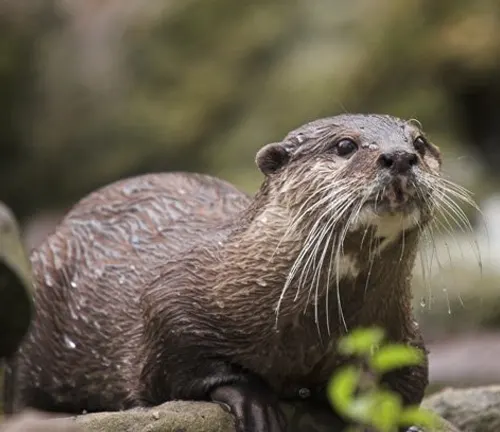
Blue Spring State Park’s fauna represents a tapestry of Florida’s diverse ecosystems, offering visitors a chance to witness and appreciate the intricate interactions among the region’s wildlife.
Attractions in Blue Spring State Park
1. Volusia Blue Spring
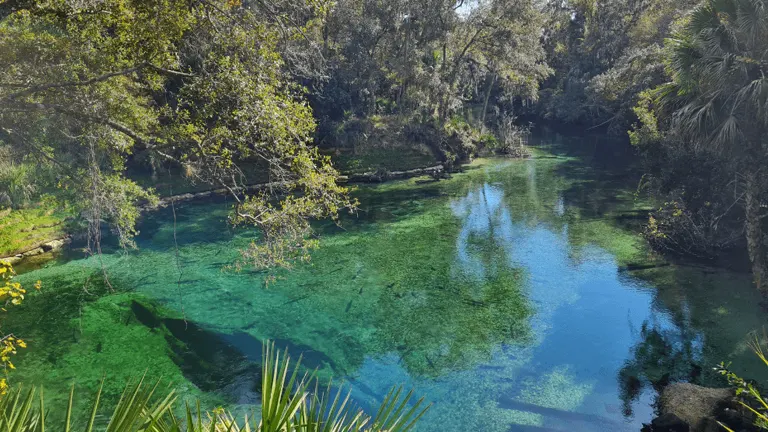
The centerpiece of Blue Spring State Park, Volusia Blue Spring, is a captivating natural spring that draws visitors year-round. Known for its crystal-clear waters and a constant temperature of 72 degrees Fahrenheit, the spring serves as a haven for Florida manatees seeking refuge during the winter months. Visitors can bask in the scenic beauty, swim in the designated areas, and explore the diverse aquatic life that thrives in this pristine environment.
2. Manatee Viewing Area
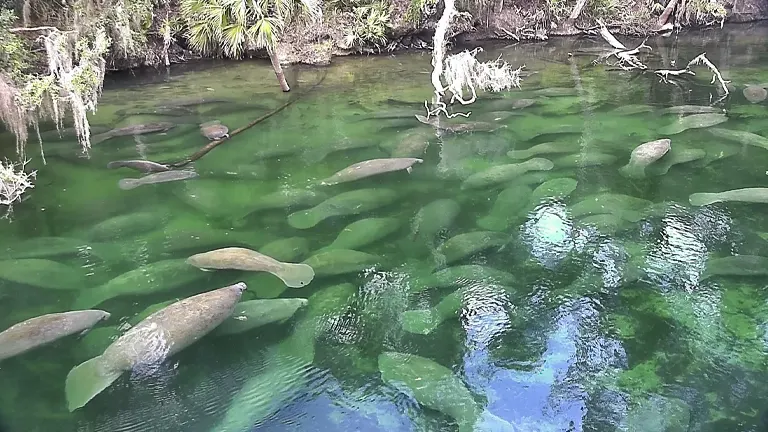
One of the park’s most cherished attractions is the designated manatee viewing area, where visitors can observe these gentle giants in their natural habitat. During the winter season, the manatees gather in the warm waters of Blue Spring, providing a unique and unforgettable opportunity for wildlife enthusiasts. Park rangers are on hand to offer insights into manatee behavior and the conservation efforts undertaken to protect these endangered marine mammals.
3. Blue Spring Boardwalk
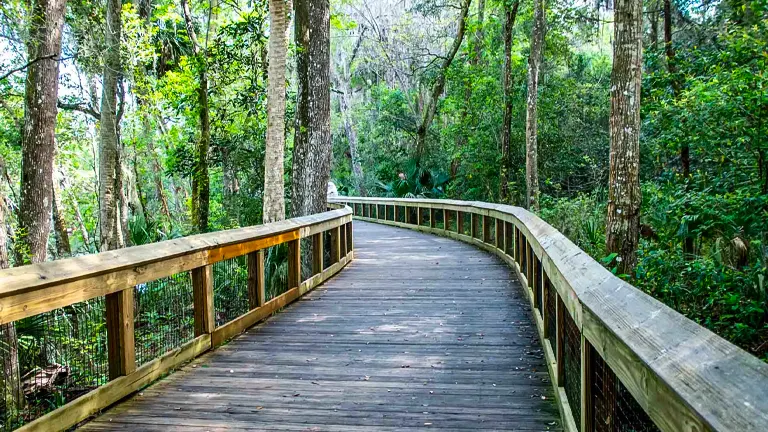
The Blue Spring boardwalk is a scenic pathway that meanders along the spring run, offering panoramic views of the lush surroundings. Stretching for 1/3 of a mile, the elevated boardwalk provides an immersive experience, allowing visitors to traverse the diverse ecosystems and witness the beauty of the spring from different perspectives. The boardwalk culminates in an observation deck, providing an ideal spot for wildlife watching and capturing the essence of the park.
4. Thursby House
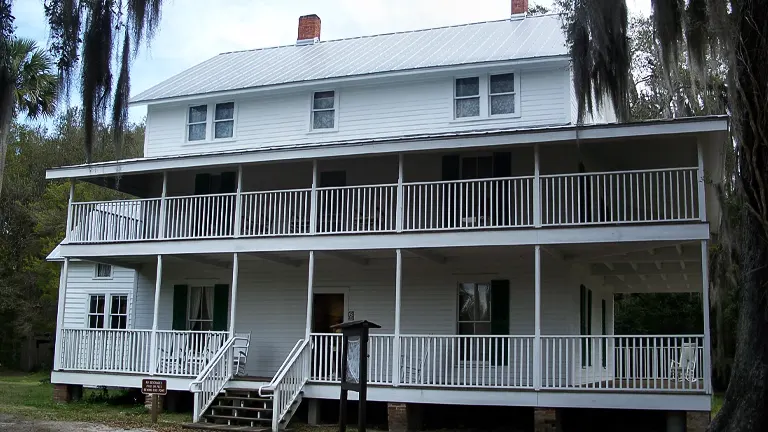
Preserving the park’s historical heritage, the Thursby House stands as a testament to the area’s past. Built in the mid-19th century, this plantation-style home reflects the transition from citrus cultivation to tourism in the region. Visitors can explore the house and its historical displays, gaining insights into the cultural and economic history that shaped Blue Spring State Park.
5. Pine Island Trail
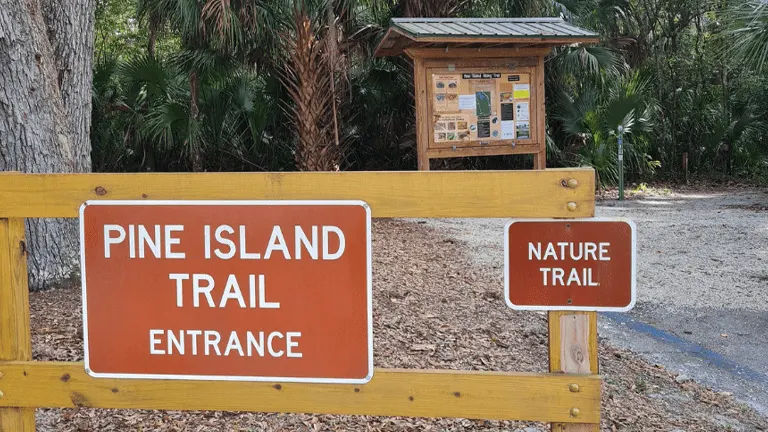
For hiking enthusiasts, the Pine Island Trail offers a 4.5-mile trek through the park’s diverse landscapes. This scenic trail winds through pine forests, hardwood hammocks, and along the St. Johns River, providing a captivating journey for nature lovers. Interpretive signs along the trail enhance the experience by providing information about the park’s natural features and ecosystems.
6. Hontoon Island State Park Connection
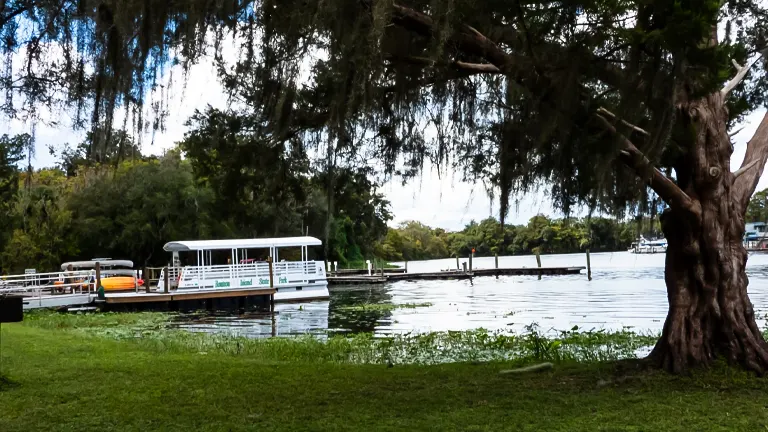
A unique aspect of Blue Spring State Park is its connection to Hontoon Island State Park. Visitors can embark on a short paddle down the St. Johns River to reach Hontoon Island, expanding their exploration of the area. This interconnected adventure provides a diverse range of landscapes and ecosystems for those eager to delve into the natural wonders along the river.
7. Wildlife Viewing Opportunities

Beyond manatees, Blue Spring State Park offers abundant opportunities for wildlife viewing. The park’s diverse habitats support a variety of bird species, river otters, alligators, and white-tailed deer. Birdwatchers can spot wood storks, barred owls, and bald eagles, making the park a haven for those seeking to connect with Florida’s rich biodiversity.
Blue Spring State Park’s attractions cater to a wide range of interests, from outdoor adventures and historical exploration to wildlife observation, ensuring a fulfilling experience for every visitor.
Recreational Activities in the Blue Spring State Park
1. Canoeing and Kayaking
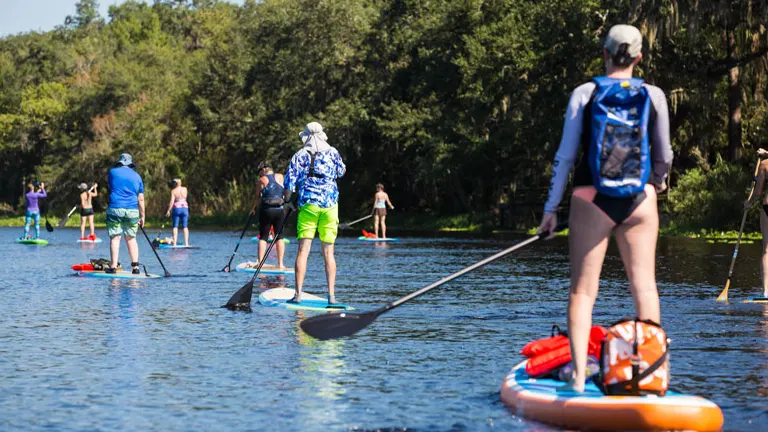
Blue Spring State Park offers a serene waterway for canoeing and kayaking enthusiasts to explore. The spring run and the St. Johns River provide an idyllic setting for paddlers to navigate through clear waters, surrounded by lush vegetation. The water activity rental station within the park allows visitors to conveniently rent canoes and kayaks, ensuring an immersive experience as they glide along the picturesque waterways, observing the diverse ecosystems and wildlife that inhabit the park.
2. Swimming

Visitors to Blue Spring State Park can enjoy a refreshing swim in the designated areas, especially during the warmer months when manatee restrictions are lifted. The spring’s crystal-clear waters offer a unique swimming experience amidst a natural oasis. Designated zones ensure both the safety of swimmers and the preservation of the park’s delicate ecosystem, allowing visitors to cool off and relax in the pristine environment.
3. Scuba Diving
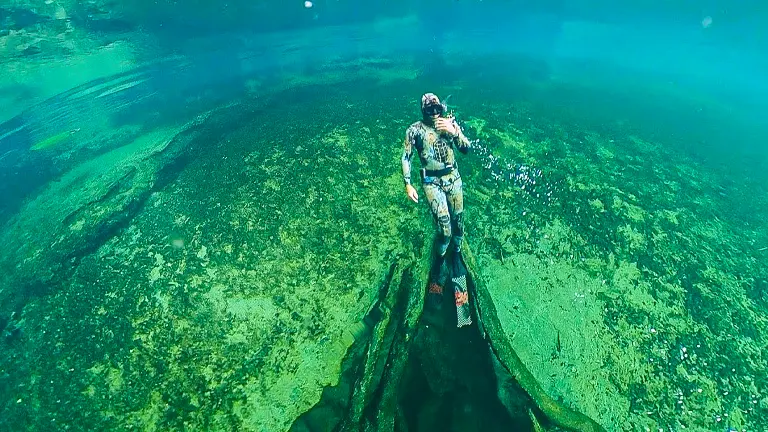
Certified SCUBA divers can embark on an extraordinary underwater adventure in Blue Spring State Park. During the designated season, divers have the exclusive opportunity to explore the spring’s underwater cave system, revealing intricate geological formations and the unique underwater landscape. With safety measures in place, the park provides a rare and thrilling experience for divers seeking to discover the hidden wonders beneath the surface of Volusia Blue Spring.
4. Hiking – Pine Island Trail
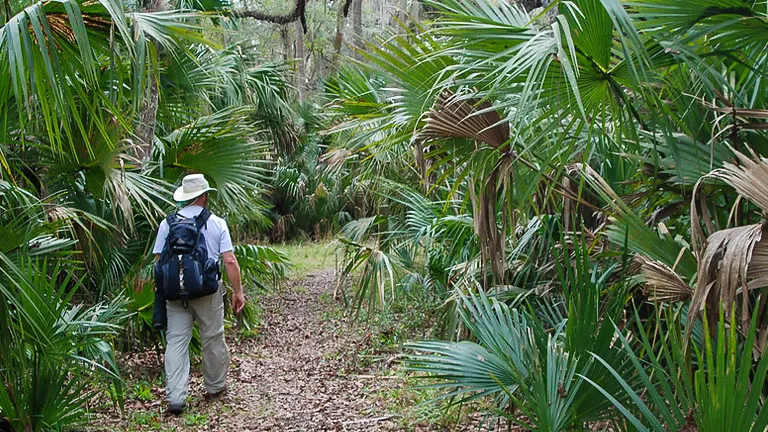
Hikers can traverse the 4.5-mile Pine Island Trail, winding through the diverse ecosystems that define Blue Spring State Park. The trail takes visitors through pine forests, hardwood hammocks, and along the St. Johns River, offering a scenic journey filled with natural beauty. Interpretive signs along the trail provide valuable insights into the park’s flora, fauna, and historical significance, making it an engaging and educational hiking experience.
5. Camping and Cabins

Extend your stay in Blue Spring State Park by taking advantage of its camping facilities and cozy cabins. The park features 51 campsites and six cabins, providing a peaceful retreat amidst nature. Campers can immerse themselves in the tranquil sounds of the outdoors, while cabins offer a comfortable and rustic accommodation option. The pet-friendly camping area allows visitors to share the experience with their furry companions, enhancing the overall camping experience.
6. Picnicking and Pavilions

Blue Spring State Park encourages outdoor gatherings and picnics with multiple pavilions strategically placed throughout the park. Shaded areas provide an ideal setting for families and groups to enjoy meals while surrounded by the park’s natural beauty. These designated picnic areas enhance the overall recreational experience, offering a place to relax, unwind, and appreciate the scenic landscapes.
7. Live Video Streaming
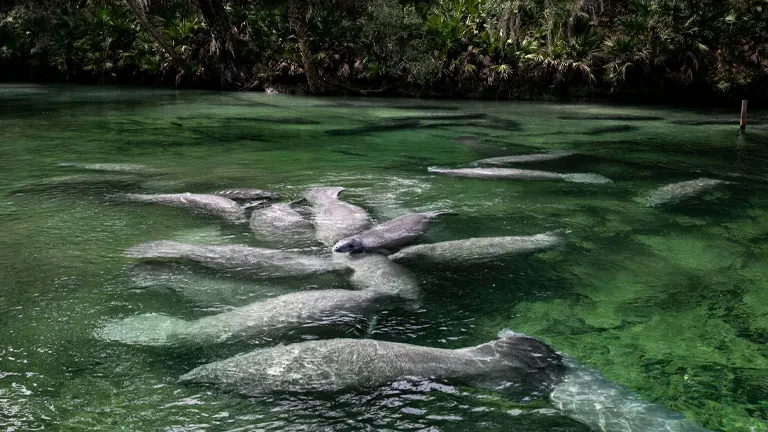
Utilizing modern technology, Blue Spring State Park provides a virtual window into its wonders. During the manatee season from November to March, the park offers live video streaming of the spring. This innovative initiative allows individuals worldwide to witness the presence of manatees in real-time, fostering awareness and appreciation for these marine mammals and the park’s commitment to conservation.
Blue Spring State Park’s array of recreational activities caters to diverse interests, ensuring that visitors can engage with nature in a responsible and enjoyable manner while contributing to the park’s conservation efforts.
Facilities and Amenities in Blue Spring State Park
- Visitor Center: Blue Spring State Park welcomes guests with a well-equipped visitor center that serves as the informational hub for park visitors. Here, guests can obtain maps, brochures, and valuable insights about the park’s natural features, recreational activities, and scheduled events. The visitor center also often hosts educational programs and exhibits, providing a comprehensive introduction to the ecological significance of Blue Spring and its diverse ecosystems.
- Water Activity Rental Station: For those eager to explore the waterways of Blue Spring, the park offers a water activity rental station. Visitors can conveniently rent canoes and kayaks, facilitating self-guided adventures along the spring run and the St. Johns River. This amenity ensures that individuals and families can easily access and enjoy water-based recreational activities without the need for personal equipment.
- Picnic Areas and Pavilions: Blue Spring State Park provides well-maintained picnic areas and pavilions, creating inviting spaces for visitors to enjoy outdoor meals amidst the natural beauty of the park. Strategically placed pavilions offer shaded locations for group gatherings, picnics, and socializing. The park’s commitment to providing comfortable and scenic picnic spots enhances the overall visitor experience.
- Camping Facilities: Nature enthusiasts looking to extend their stay at Blue Spring can take advantage of the park’s camping facilities. With 51 campsites available, visitors can immerse themselves in the peaceful surroundings and enjoy a closer connection to nature. The camping area is equipped with necessary amenities, ensuring a comfortable and enjoyable camping experience. The pet-friendly policy adds an extra layer of inclusivity for those traveling with furry companions.
- Cabins: Blue Spring State Park offers a more secluded and comfortable accommodation option with six cabins available for rent. These cozy cabins provide a rustic retreat for visitors, complete with essential amenities. Ideal for those seeking a blend of nature and comfort, the cabins allow guests to unwind after a day of exploration while still being immersed in the serenity of the park’s surroundings.
- Restrooms and Showers: Blue Spring State Park prioritizes visitor comfort with well-maintained restroom facilities and showers. These amenities are strategically located throughout the park, ensuring convenience for visitors engaging in various recreational activities. Clean and accessible facilities contribute to a positive overall experience for guests spending extended periods within the park.
- Gift Shop: The park’s gift shop provides an opportunity for visitors to take home a tangible memento of their Blue Spring experience. Stocked with a variety of nature-themed souvenirs, books, and local crafts, the gift shop supports the park’s conservation efforts through the proceeds from purchases. It serves as a reminder of the unique ecosystems and experiences encountered during a visit to Blue Spring State Park.
- Foodservice and Supplies: Blue Spring State Park caters to visitors’ practical needs by offering foodservice options and a supplies station. Whether craving a snack after a day of exploration or in need of essential supplies for camping or picnicking, the park ensures that visitors have access to convenient facilities, enhancing the overall convenience and enjoyment of their stay.
- Playground and Volleyball Courts: Families with children can take advantage of the playground within Blue Spring State Park, providing a recreational space for younger visitors to enjoy. Additionally, volleyball courts offer opportunities for group activities and friendly competitions, adding an active and social dimension to the park’s amenities.
Blue Spring State Park’s comprehensive facilities and amenities are designed to cater to the diverse needs and preferences of its visitors, ensuring a comfortable, educational, and enjoyable experience for all who explore its natural wonders.
Tips for Visiting Blue Spring State Park
- Visit During Manatee Season: The best time to witness the awe-inspiring presence of manatees in Blue Spring is during the winter months, typically from November to March. This is when the gentle giants migrate to the warm waters of the spring, providing a unique opportunity for observation. Planning your visit during manatee season increases the likelihood of encountering these remarkable marine mammals in their natural habitat.
- Check Manatee Activity Updates: Before heading to Blue Spring State Park, consider checking for manatee activity updates. The park often provides real-time information about the number of manatees present, ensuring visitors can maximize their chances of witnessing these gentle creatures. Updated information is particularly crucial during peak manatee season, allowing visitors to plan their activities accordingly.
- Arrive Early for Parking: Blue Spring State Park can get busy, especially during weekends and peak seasons. To secure convenient parking and make the most of your day, consider arriving early. Early morning visits not only provide better parking options but also offer a quieter and more serene experience as you explore the park’s natural wonders.
- Utilize the Boardwalk and Observation Deck: Make sure to explore the extensive boardwalk that runs along the spring run. This elevated pathway provides breathtaking views of the surrounding landscapes and offers an ideal vantage point for manatee watching. The boardwalk culminates in an observation deck, providing an unobstructed view of the spring and its resident wildlife. It’s a perfect spot for capturing memorable moments and immersing yourself in the beauty of Blue Spring.
- Participate in Ranger-Led Programs: Enhance your visit by participating in the ranger-led programs offered by the park. These educational sessions cover various aspects of Blue Spring’s ecology, history, and conservation efforts. Ranger-led programs can provide valuable insights, answering questions, and fostering a deeper appreciation for the park’s natural and cultural heritage.
- Respect Wildlife Viewing Guidelines: Blue Spring State Park prioritizes the well-being of its wildlife inhabitants. When engaging in wildlife viewing activities, adhere to the park’s guidelines to ensure minimal disturbance to the animals. Maintain a respectful distance, avoid loud noises, and use binoculars or cameras with zoom lenses for close-up observation, promoting ethical wildlife watching practices.
- Explore the Pine Island Trail: For nature enthusiasts and hikers, the 4.5-mile Pine Island Trail offers a scenic journey through diverse ecosystems. This well-maintained trail showcases the park’s natural beauty, providing opportunities to observe flora and fauna along the way. Interpretive signs offer educational insights, making it an engaging and informative trek.
- Pack Essentials for Day Trips: Whether you’re planning a day trip or an extended stay, pack essentials such as sunscreen, water, comfortable footwear, and insect repellent. These items ensure a comfortable and enjoyable experience as you explore the park’s trails, engage in water activities, or relax in designated picnic areas.
- Check for Seasonal Restrictions: Blue Spring State Park implements seasonal restrictions to protect its ecosystem, particularly during manatee season. Be aware of any restrictions on water activities, swimming, or diving during specific months. These measures are crucial for preserving the natural habitat and ensuring the safety of both visitors and wildlife.
- Capture Memories Responsibly: While capturing the beauty of Blue Spring is encouraged, do so responsibly. Follow Leave No Trace principles, refrain from feeding wildlife, and avoid disrupting natural habitats. Responsible photography allows you to document your experience without negatively impacting the delicate balance of the park’s ecosystems.
By incorporating these tips into your visit to Blue Spring State Park, you can ensure a memorable and respectful experience while contributing to the conservation efforts that safeguard this Florida gem.
Recommendation
I highly recommend discovering Blue Spring State Park for a captivating fusion of natural wonders and historical importance. This park, celebrated for its varied ecosystems, iconic landmarks, and a range of recreational pursuits, provides a distinctive and immersive adventure. Immerse yourself in contemplative outdoor activities like hiking and wildlife observation while actively participating in the ongoing conservation endeavors. The picturesque trails, historical points of interest, and collaborative conservation initiatives position Blue Spring State Park as a key destination for individuals seeking a harmonious blend of nature and recreational exploration.
Conclusion
In conclusion, Blue Spring State Park stands as a true gem, offering visitors a symphony of natural beauty, recreational opportunities, and a commitment to conservation. The allure of the park lies not only in the crystal-clear waters of Volusia Blue Spring but also in its diverse ecosystems, historical landmarks, and the abundance of wildlife that call it home. From the majestic manatees seeking refuge in the warmer winter months to the scenic trails winding through pine forests and along the St. Johns River, the park invites exploration and connection with Florida’s rich biodiversity. The thoughtful inclusion of amenities such as camping facilities, cabins, and educational programs ensures that visitors can fully immerse themselves in the tranquility and wonders of the park. Blue Spring State Park stands not just as a destination for outdoor enthusiasts but as a testament to the importance of preserving and appreciating the delicate balance of our natural world.
FAQs
- What makes Blue Spring State Park unique for wildlife enthusiasts?
Blue Spring State Park is renowned for being a haven for wildlife, particularly during the winter months when over 700 manatees gather in the warm waters of Volusia Blue Spring. The park’s diverse ecosystems also support a rich variety of bird species, river otters, alligators, and more, making it a paradise for wildlife observation. - Can visitors swim in Blue Spring, and when is the best time for it?
Yes, visitors can swim in designated areas of Blue Spring. The best time for swimming is during the warmer months when manatee restrictions are not in place, typically from April to October. This allows guests to enjoy the cool, crystal-clear waters while respecting the natural habits of the resident manatees during their migration season. - What recreational activities are available during manatee season?
While water activities such as swimming, canoeing, and kayaking are restricted during manatee season (November to March), visitors can still engage in land-based activities. Hiking along the trails, exploring historical sites, and participating in ranger-led programs offer unique ways to experience the park’s beauty while respecting the presence of the manatees. - Are there accommodations available for overnight stays at Blue Spring State Park?
Yes, Blue Spring State Park offers camping facilities with 51 campsites and six cozy cabins available for rent. Whether camping under the stars or enjoying the comfort of a cabin, visitors can extend their stay and immerse themselves in the natural surroundings of the park. - How does Blue Spring State Park contribute to manatee conservation?
Blue Spring State Park has been instrumental in manatee conservation efforts since its acquisition by the Florida Department of Environmental Protection in 1972. The park actively engages in research, maintaining one of the world’s most extensive manatee databases. Educational initiatives, including live video streaming during manatee season, contribute to public awareness and conservation advocacy. - What precautions should visitors take during their visit to Blue Spring?
Visitors are encouraged to follow ethical wildlife viewing guidelines, respecting the natural behaviors of animals. It’s crucial to maintain a safe distance from wildlife, refrain from feeding them, and use binoculars or cameras with zoom lenses for observation. Additionally, adherence to park rules, especially during manatee season, ensures a positive experience for all. - Can I engage in SCUBA diving in Blue Spring?
Certified SCUBA divers have the unique opportunity to explore Blue Spring’s underwater cave system during the designated season. This thrilling experience allows divers to witness the geological formations beneath the spring’s surface while adhering to the park’s safety guidelines and seasonal restrictions. - How can visitors support the conservation efforts of Blue Spring State Park?
Visitors can actively contribute to the conservation of Blue Spring by practicing responsible outdoor ethics, participating in educational programs, and supporting the park’s initiatives. Donations, volunteering, and spreading awareness about the importance of preserving natural habitats further aid in the ongoing efforts to protect the park’s ecosystems.
As you wrap up your time at Blue Spring State Park, take with you the memories of its clear waters, diverse landscapes, and the unique experiences it offers. Until your next visit, here’s to the simple joys of nature and the beauty of this Florida retreat.





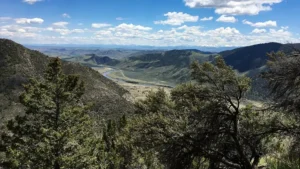

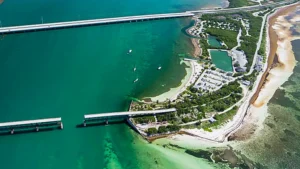

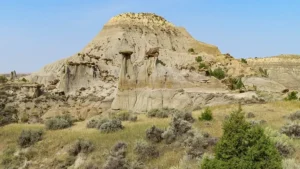
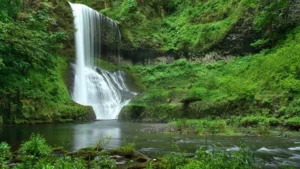
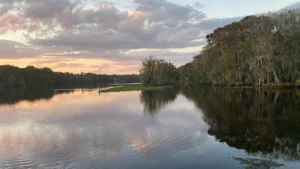
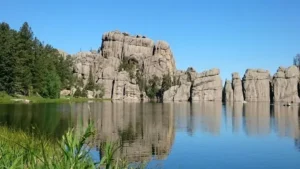

Leave your comment